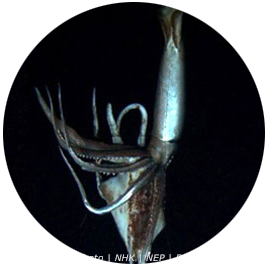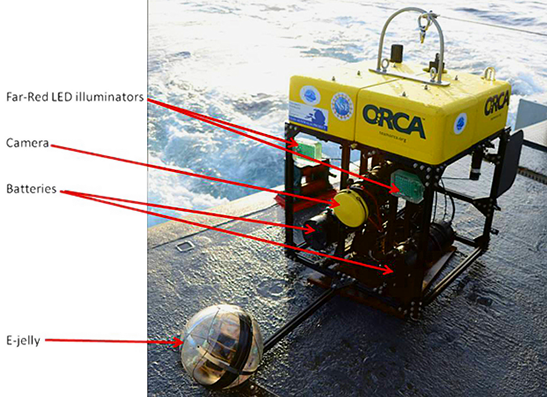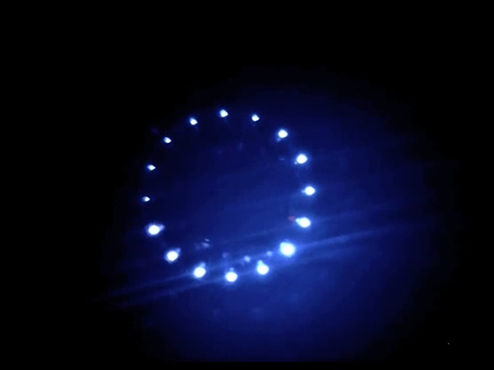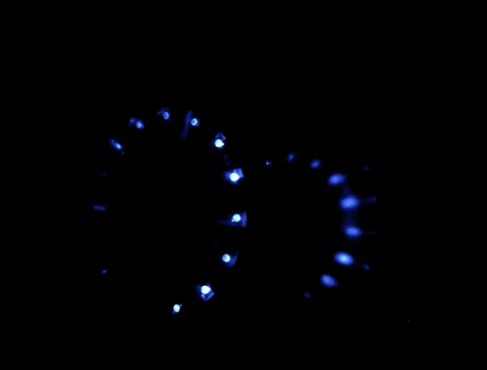Giant Squid
Giant Squid Filmed for the First Time.
The giant squid (Architeuthis) was filmed for the first time in its natural habitat with help from ORCA’s Dr. Edie Widder.
 This achievement has been a long time coming.
This achievement has been a long time coming.
There have been previous such expeditions – all failures. This time was different. There were many factors that came together to make this effort such a resounding success. One of these was a new approach to deep ocean exploration that pays heed to the natural visual environment of the vast midwater realm that is home to these leviathans. This is a world of the very dimmest of lights – both sunlight filtered through hundreds of meters of ocean and – bioluminescence – the living light that animals use to aid their survival in a light-limited world. The enormous eye of the giant squid – the largest in the animal kingdom – attests to how important vision must be to its survival. The teams’ use of optical lures that imitate bioluminescence to attract the squid and far red light invisible to the squid in order to see without being seen proved to be the key to success.
The Road to Success
The expedition was initiated with financing from the Japan Broadcasting Corporation, NHK, which was inspired to undertake the high-risk endeavor – despite the failures of previous attempts – by the success of Japanese squid expert Dr. Tsunemi Kubodera who was the first person to capture still images of the Giant Squid using a baited underwater camera.
Dr. Widder was invited to join the expedition because of her successes with the Eye-in-the-Sea, a deep-sea camera observatory that she developed as a means of exploring the deep ocean unobtrusively. The Eye-in-the-Sea uses low light imaging in combination with far-red illumination that is invisible to most deep-sea animals. The primary motivation for its development was the desire to observe animals that would normally be disturbed or frightened away by the white lights and noisy thrusters used on standard observation platforms.
Dr. Widder also developed a novel optical lure that imitates certain bioluminescent displays, thought to be attractive to large predators. Known as the electronic jellyfish or e-jelly the lure imitates the bioluminescent burglar alarm display of the common deep-sea jellyfish Atolla wyvillei.
Bioluminescent burglar alarms are a scream for help – the last ditch efforts of an animal that is caught in the clutches of a predator and has no other hope for survival than to attract the attention of a larger predator that may attack their attacker and thereby afford them an opportunity for escape. It was hoped that such a display would be of great interest to a visual predator like the giant squid.
The Medusa does it again—this time in our own backyard—and the discovery goes viral.
NY Times: Giant squid reappears on video, this time in US waters
The Washington Post: Scientists captured video of a giant squid. Watch the sea creature emerge from the darkness
National Geographic: How scientists got that amazing giant squid video
USA Today: A stunning, elusive giant squid was captured on video in US waters for first time
The Medusa
 The Medusa was designed for in situ video documentation of biota and collection of water quality parameters, at an operational depth of 2000m. The autonomous and compact observational instrumentation records video in ultra-low light conditions with a highly sensitive camera and DVR recording system. Epoxy encapsulated LED arrays offer virtually unobtrusive ‘far red’ illumination at a wavelength of 690 nanometers. The submersible data logger records conductivity, salinity, temperature, pressure, depth, and PAR. Versatile deployment options enable the Medusa to be deployed from a small boat or ship and operate in a moored, lander, or drifter mode. Upon completion of the 72 hour operation, a weight is dropped via acoustic release and the Medusa is retrieved with a davit and winch. Invaluable information is obtained through the unobtrusive data recording of the Medusa.
The Medusa was designed for in situ video documentation of biota and collection of water quality parameters, at an operational depth of 2000m. The autonomous and compact observational instrumentation records video in ultra-low light conditions with a highly sensitive camera and DVR recording system. Epoxy encapsulated LED arrays offer virtually unobtrusive ‘far red’ illumination at a wavelength of 690 nanometers. The submersible data logger records conductivity, salinity, temperature, pressure, depth, and PAR. Versatile deployment options enable the Medusa to be deployed from a small boat or ship and operate in a moored, lander, or drifter mode. Upon completion of the 72 hour operation, a weight is dropped via acoustic release and the Medusa is retrieved with a davit and winch. Invaluable information is obtained through the unobtrusive data recording of the Medusa.
ORCA’s Optical Lure the "eJelly"
Bioluminescent animals communicate with light. Many deep-sea creatures use light to attract or find prey, to attract a mate or to fend off predators. ORCA used this principal to develop an optical lure that imitates certain bioluminescent displays – like the burglar alarm display of the common deep-sea jellyfish, Atolla. When this jellyfish is caught in the clutches of a predator it produces a pinwheel of light that is like a scream for help. It serves to attract the attention of a larger predator who will attack the attacker thereby affording the jellyfish a chance for escape. It’s a very effective lure that has proved highly attractive to deep-sea squid.


